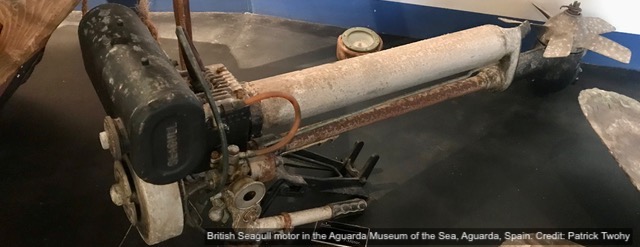Reliable Old Relics
In a corner of a village fishing museum in Spain a few weeks ago, I came across an item that got me thinking about hardy seafarers.
As pilgrims walking The Way toward Santiago de Compostela ambled by outside, I pondered a somewhat more modern relic — a British Seagull outboard motor on display. It was apparently once used by fishermen in this Atlantic Galician seacoast town. The motor lay on its side, beside a tiny wooden boat and other fishing paraphernalia with little explanation. A tag next to it, not too helpfully, declared, “7 – Motor.”


A slightly closer look made things clearer to someone with a bit of prior knowledge. The label on the black fuel tank read, “Seagull.” Aha! An example of something that, to many sailors, might seem a contradiction in terms: A reliable outboard motor, and a British one at that. The Seagull was on display in a town known in the Galician dialect as Aguarda, or La Guardia in Spanish and Agarda to the Portuguese a stone’s throw away across the Rio Mińo (or Minho). This one could no longer be considered reliable as anything other than an anchor, I suppose. But it’s kind certainly could be.
So what’s the deal? A reliable outboard? And even more, a reliable piece of mechanical equipment manufactured in Britain?

British Seagull motors, single-cylinder, two-stroke babies, were manufactured in Poole, on the south coast of England, from the early 1930s into the 1990s. Seagull had once made motorcycles, but switched in late 1930s, on the eve of World War II. Aficionados still operate them today. Spare parts are available, and you can buy a clean one on eBay for not much less than you’d spend for a modern outboard.
(With apologies to Anglophiles, Britain’s reputation for constructing anything with an engine took a huge hit in the latter decades of the 20th century. If you owned a British sports car, as my father, and later my wife, did, you’d know you’d best be on good terms with your mechanic.)

So yes, in the days before MG, and even Jaguar, built crap, there was British Seagull.
A guy posting on cruisers forum.com notes that Seagulls are noisy, they smoke because, as a two-stroke motor, they require as much as a 10:1 fuel to lube oil mixture in the tank, and they tend to leak when in the up position. But, he said, “Once you get them to run properly it is hard to kill them. I overturned a dinghy in the surf while the engine was running once and took it ashore and cleaned it up and had it running again within 15 minutes.” Others tell tales of using a Seagull as an emergency anchor overnight then being able to start it on the third pull the next day.
Um, right.
As writer John Vigor notes in a piece on goodoldboat.com, “The yachting scene is awash with stories about Seagulls, mostly apocryphal.” Despite the tall tales, Seagull’s reputation for reliability endures. Some say it’s because there’s just not that much on them to break. A part can’t break if it doesn’t exist. Others note that the reliability was no accident. Seagulls were built with parts meant to last.
During the 1950s, news commentator John Cameron Swayze used to do live TV commercials for Timex watches by strapping a watch to the propeller of a big outboard engine and then running the engine in a tank for awhile. The Timexes generally took the licking and kept on ticking. But sometimes other things went wrong. In one spot, the watch band broke and the watch was never seen again. In another, the engine kept dying, but Swayze kept on talking about the reliability of his Timex. (youtube.com/watch?v=Vgsvnvf6UGA) Maybe he should have used a Seagull!
During the motor’s heyday in the 1970s, the builder was selling 80,000 Seagulls a year. They began to fall out of fashion after that as more modern Japanese and American outboard models came on the scene, and environmental rules made it more difficult to justify a motor that spews lube oil and smoke. Manufacturing ended in 1996.
But the mystique carries on. Next time you find yourself struggling with a recalcitrant outboard, take a rest for a moment and ponder, as I did, these dirty, noisy, reliable old relics.



